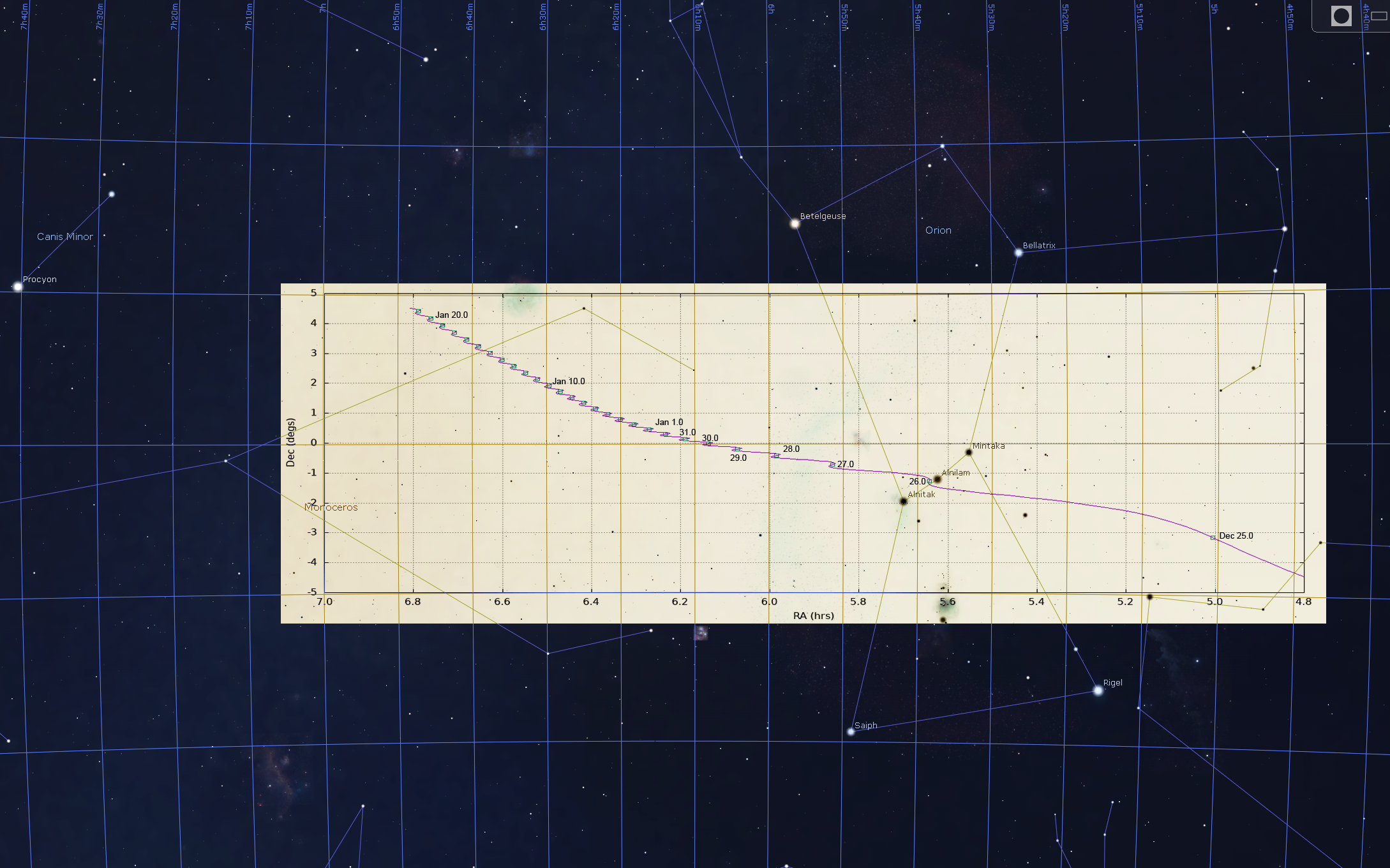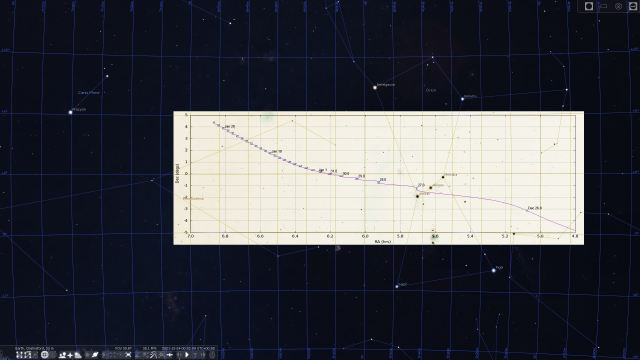› Forums › General Discussion › Following JWST through Orion to L2
- This topic has 63 replies, 14 voices, and was last updated 3 years, 10 months ago by
 Nick James.
Nick James.
-
AuthorPosts
-
19 December 2021 at 9:59 pm #575123
 Nick JamesParticipant
Nick JamesParticipantThe James Webb Space Telescope is now scheduled for launch on Ariane 5 flight VA256 on Christmas eve at at 12:20 UTC.
Following launch it should be a relatively easy object for us to follow as it transfers to L2. The magnitude is a bit uncertain but Gaia was 10th magnitude on the first night after launch, fading to 18th mag 3 nights later and around 20-21 at L2. Gaia was particularly faint, WMAP and Planck were both between 18-19 at L2. JWST is much bigger than these so should be brighter but this will depend on the exact solar aspect angle and properties of the sunshield. It will be interesting to see how bright (or not) it is.
You can get an ephemeris from JPL Horizons. Just search for JWST and make sure to configure your observatory location since there will be considerable parallax early on. Attached is the ephemeris for my observatory (it is a text file, just change the ending to txt to view it). The first night after launch it has a very high apparent motion in Orion but should be an easy visual target. It stays in Orion until Jan 4 when it moves into Monoceros.
Please post reports and images on your members’ page. Let’s see how far we can follow it.
 20 December 2021 at 10:20 am #585026
20 December 2021 at 10:20 am #585026 Dr Paul LeylandParticipant
Dr Paul LeylandParticipantI will see what I can do, but as Tacande Observatory won’t be back in operation until February at the very earliest it will likely take relatively long duration imaging. Gaia is still within range of my kit (must try for it one day) so JWST shouldn’t be too much of a problem.
Thanks for suggesting this target!
20 December 2021 at 7:32 pm #585029 Grant PrivettParticipant
Grant PrivettParticipantNicely placed for observation from the UK then. I’m looking forward to imaging this.
How far apart will it be from the vehicle that launched it?
20 December 2021 at 9:30 pm #585030 Nick JamesParticipant
Nick JamesParticipantIt is very well placed for us and everyone but that is not entirely a coincidence. It is going in the anti-solar direction and the launch is scheduled to avoid getting too close to the Moon. Winter is definitely good for us in the northern hemisphere since L2 is currently high in the sky.
There’s not much detail available about what will happen to the cryogenic upper stage following JWST separation which occurs at around 30 minutes after launch. JWST is directly injected into a transfer orbit to L2 so the upper stage will probably be close by but it will probably do some form of deflection burn and JWST itself will do its first course correction at L+12.5h so the two will drift apart. There is another course correction burn scheduled for L+60h. I don’t know how bright the upper stage will be but on the first few nights I would expect it would be detectable and fairly close to the spacecraft. I’ve imaged Centaur upper stages at ranges of more than 700,000 km and the Falcon 9 upper stage at 400,000km but the Ariane upper stage is smaller I think. The Centaurs also do propellant dumps which can be interesting to watch. I assume that the Ariane stage does something similar.
21 December 2021 at 9:13 pm #585031Neil Morrison
ParticipantThank you for the heads up Nick. The 26th looks an interesting point to start this imaging project.
I plan to get some new reference images of Orion’s Belt using a 85 mm F1.4 Samyang lens for semi wide angle shots and also some other frames of a narrower angle perhaps the 500mm F 5.5 Star Sky weather permitting and hopefully with the launch on schedule and clear weather possibly spot the JWST on the images as an interloper . .
22 December 2021 at 10:55 am #585032 owen brazellParticipant
owen brazellParticipantUnfortunately due to weather conditions the launch is delayed until at least Saturday and from what I have seen the forecasts for Korou do not look much better then. Not sure how this impacts where it can be seen. Bit of a shame with the rocket and satellite now ready the weather throws its usual spanner in the works.
22 December 2021 at 11:21 am #585033 Daryl DobbsParticipant
Daryl DobbsParticipantHopefully the weather will improve but the link below is to the NASA press release
https://www.nasa.gov/feature/james-webb-space-telescope-launch-update
22 December 2021 at 11:57 am #585034 Alex PrattParticipant
Alex PrattParticipantFrom a selfish point of view I welcome the delay in launching JWST, at least until there’s a chance of any clearing in this interminable cloud cover to observe it. The JWST will get to L2 before I see any stars again…!
Alex.
22 December 2021 at 2:09 pm #585035 Dr Paul LeylandParticipant
Dr Paul LeylandParticipantJust Wait, Still Terrestrial.
22 December 2021 at 6:47 pm #585036 Nick JamesParticipant
Nick JamesParticipantSince the launch window opens at about the same solar time every day the chart should remain valid by just offsetting the dates, so, for instance, if it does go up on Christmas day then substitute 27.0 for 26.0 and so on. There will be an eastward drift of 4 mins a day in RA as well. In any case the JPL Horizons ephemeris will be updated to reflect the actual launch time.
23 December 2021 at 6:28 pm #585037 Tim HaymesParticipant
Tim HaymesParticipantWhen i enter the info asked for i get a load of stuff about JWST in red, but no list. Is there a glitch with the system?
23 December 2021 at 7:48 pm #585038 Nick JamesParticipant
Nick JamesParticipantMost likely you have a start time set before the launch time. The last line of all those error messages is:
No ephemeris for target “James Webb Space Telescope (spacecraft)” prior to A.D. 2021-DEC-25 12:48:00.0000 UT
23 December 2021 at 8:03 pm #585039 Nick JamesParticipant
Nick JamesParticipantHere is a revised chart for the current Dec 25 launch. You can see that it follows pretty much the same path, shifted around 4 minutes east a day.
 25 December 2021 at 9:52 am #585041
25 December 2021 at 9:52 am #585041 David SwanParticipant
David SwanParticipantHappy Christmas all! Fingers crossed that JWST launches without a hitch today, and that the whole sequence of further manoeuvres (and unpacking) goes as planned. The weather forecast for NE England over the next week shows a lot of cloud unfortunately. But I would love to image it whilst en route to L2.
25 December 2021 at 11:06 am #585042 Alex PrattParticipant
Alex PrattParticipantNow watching the pre-launch coverage on NASA TV… 🙂
Alex.
25 December 2021 at 12:55 pm #585043 Peter MulliganParticipant
Peter MulliganParticipantIt has just unfurled its Solar array great launch
25 December 2021 at 3:38 pm #585044 Dr Paul LeylandParticipant
Dr Paul LeylandParticipant3 minutes early…
25 December 2021 at 6:09 pm #585045 Nick JamesParticipant
Nick JamesParticipantIt was great to see the solar array deployment live via the upper stage camera. The launch certainly added some excitement to Christmas lunch and the Ariane 5 performed very well. Now, if only we could get a clear patch between the torrential rain…
26 December 2021 at 12:00 am #585046 Nick JamesParticipant
Nick JamesParticipantDenis Buczynski (Tarbatness) managed to get the spacecraft tonight at mag 12.3 which is a bit fainter than I expected. Luca Buzzi reports via MPML that the upper stage is around the same magnitude and about half a degree west of the spacecraft. There will probably be a significant effect on the magnitude when the sunshade gets deployed. Total washout here.
26 December 2021 at 4:04 pm #585047Neil Morrison
ParticipantThe Launch certainty added a new dimension to cooking Xmas lunch, dashing between Kitchen and Nasa TV on Computer.
Its the best Xmas present the Astronomical Community could wish for lets hope that it continues to deliver its potential as it slowly deploys.
-
AuthorPosts
- You must be logged in to reply to this topic.
